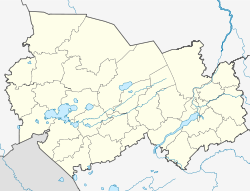
Novosibirsk is the largest city and administrative centre of Novosibirsk Oblast and the Siberian Federal District in Russia. As of the 2021 Census, it had a population of 1,633,595, making it the most populous city in Siberia and the third-most populous city in Russia after Moscow and Saint Petersburg. The city is located in southwestern Siberia, on the banks of the Ob River.

Novosibirsk Oblast is a federal subject of Russia located in southwestern Siberia. Its administrative and economic center is the city of Novosibirsk. As of the 2021 Census, Novosibirsk Oblast had a population of 2,797,176.
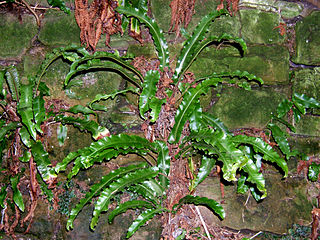
Asplenium scolopendrium, commonly known as the hart's-tongue fern, is an evergreen fern in the family Aspleniaceae native to the Northern Hemisphere.

Berdsk is a town in Novosibirsk Oblast, Russia. A suburb of Novosibirsk, it is on the Berd River. In the 2010 Russian census, its population was 97,296 (2010 Census).

Aire Point to Carrick Du SSSI is a Site of Special Scientific Interest on the Penwith Peninsula, Cornwall, England. It is 5.98 square kilometres in extent, stretching from grid reference SW360279 to grid reference SW513410. The site is designated both for its biological and its geological interest.

Salair Ridge is an eroded plateau-type highland of low elevation in the Southwestern Siberia, Russia, particularly in Altai Krai, Kemerovo and Novosibirsk Oblast. It is a natural continuation of Altai Mountains and separates the Kuznetsk Depression from the Ob River Plain to the southwest. Its main ridge is nearly parallel to that of Kuznetsk Alatau. The ridge is some 300 kilometres in length and 15-40 kilometres wide.

A natural monument is a natural or cultural feature of outstanding or unique value because of its inherent rarity, representative of aesthetic qualities, or cultural significance. They can be natural geological and geographical features such as waterfalls, cliffs, craters, fossil, sand dunes, rock forms, valleys and coral reefs. Locations important to faith groups may be considered natural monuments. Archeological and historical sites linked to the natural environment are also included, such as cave art. This is especially true when relevant to the land of Indigenous Peoples.

The Japanese murrelet or crested murrelet is a small seabird in the auk family that occurs along the remote rocky coasts and in the offshore waters of Japan, and may also be found after the breeding season as far as Sakhalin to the north and in particular off South Korea. With a small and declining population, estimated as of 2017 to total 2,500–10,000 individuals, it is the rarest alcid, and the most at risk of extinction.

Asplenium ceterach, also known as the rustyback fern, is a fern species in the spleenwort family Aspleniaceae.

Asplenium trichomanes, the maidenhair spleenwort, is a small fern in the spleenwort genus Asplenium. It is a widespread and common species, occurring almost worldwide in a variety of rocky habitats. It is a variable fern with several subspecies.

Asplenium ruta-muraria is a species of fern commonly known as wall-rue. It is a very small epipetric species, growing exclusively on limestone and other calcareous rocks. Its fronds are bluish-green and are heavily sub-divided, becoming up to 12 cm in length.

Hexhamshire Moors is a Site of Special Scientific Interest covering an extensive area of moorland in the Wear Valley district of north-west County Durham and the Tynedale district of south-west Northumberland, England.

Asplenium viride is a species of fern known as the green spleenwort because of its green stipes and rachides. This feature easily distinguishes it from the very similar-looking maidenhair spleenwort, Asplenium trichomanes.

The Flag of Novosibirsk Oblast is the official symbol of Novosibirsk Oblast, Russia.
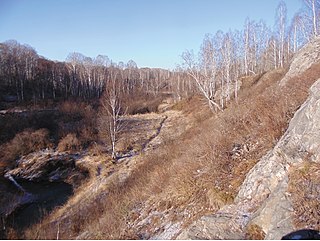
Maslyaninsky District is an administrative and municipal district (raion), one of the thirty in Novosibirsk Oblast, Russia. It is located in the east of the oblast. The area of the district is 3,453 square kilometers (1,333 sq mi). Its administrative center is the urban locality of Maslyanino. Population: 24,438 ; 27,196 (2002 Census); 26,421 (1989 Census). The population of Maslyanino accounts for 53.6% of the district's total population.

Râpa Roșie is a protected area, a natural monument of national interest in Alba County, Romania. It is a geological and botanical reserve, located in the extreme southwest of the Secașelor Plateau, on the right bank of the river Secașul Mare, about 4 kilometres (2.5 mi) north of Sebeș. With a size of approximately 24 hectares, the reserve is classified as IUCN Category III.
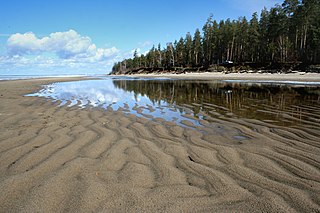
Berd Spit is a city park in Berdsk of Novosibirsk Oblast, Russia. It is a specially protected natural area since 2006.
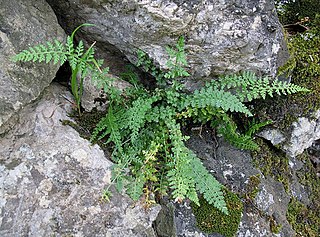
Asplenium fontanum, commonly known as fountain spleenwort or smooth rock spleenwort, is a species of fern in the family Aspleniaceae, native to rocky areas in Western Europe.
Barsukovskaya Cave is a karst cave in Maslyaninsky District of Novosibirsk Oblast. Its length is more than 100 meters. The depth of the cave is 19 meters.

